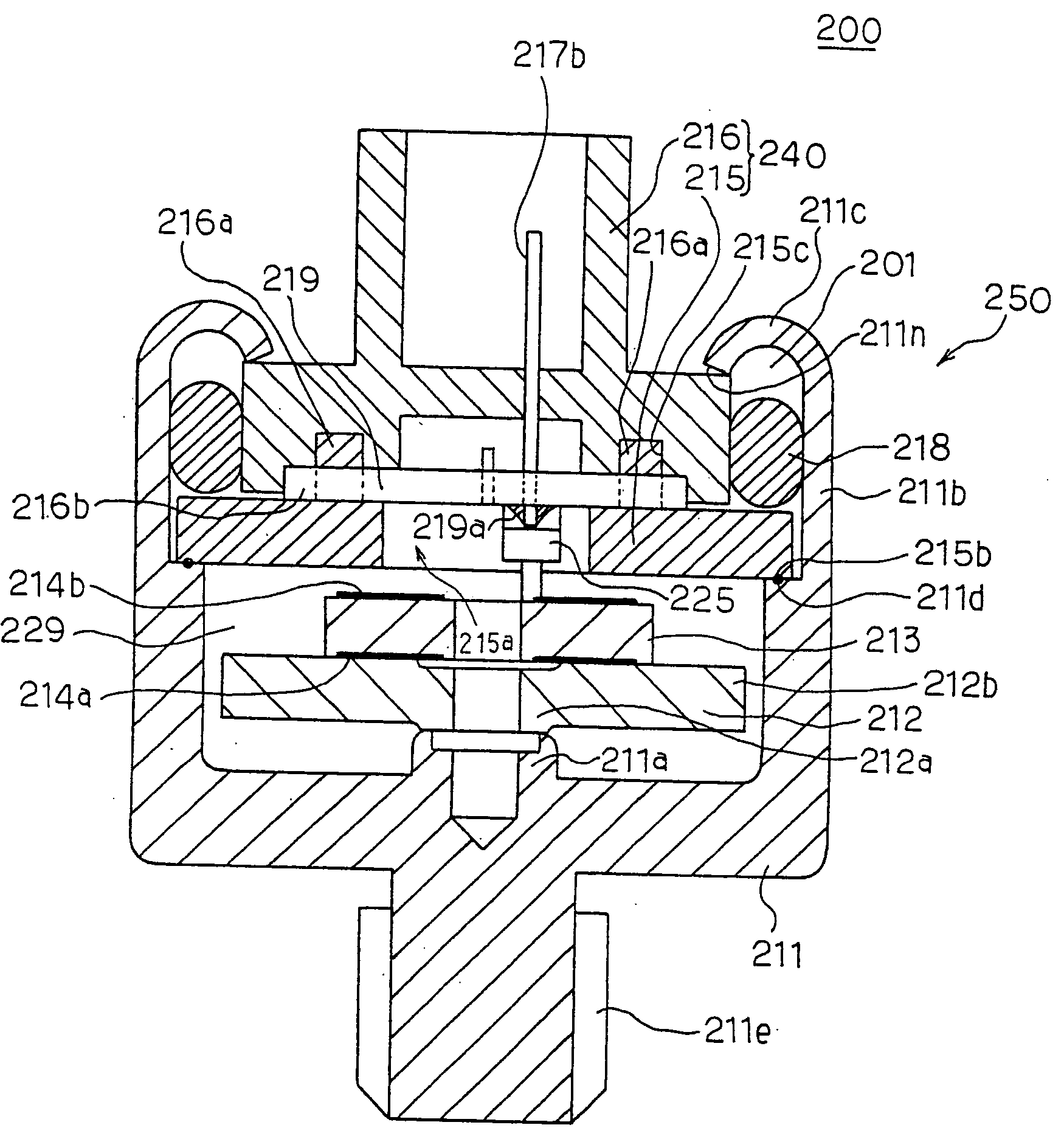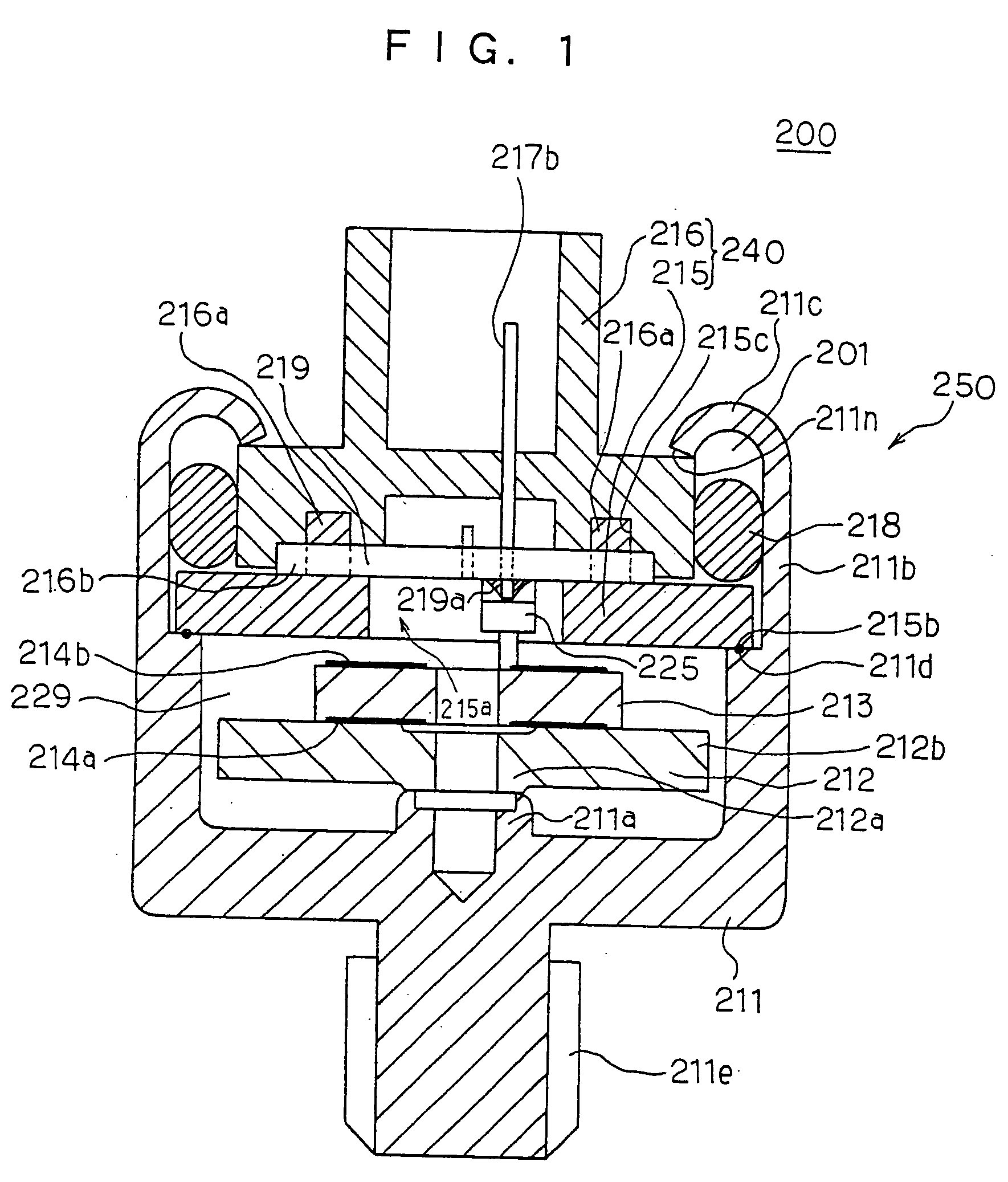Acceleration sensor
a technology of acceleration sensor and acceleration sensor, which is applied in the direction of rapid change measurement, instruments, measurement devices, etc., can solve the problems of deteriorating the accuracy of acceleration sensor, difficulty in automatically assembling acceleration sensor, and rise in the production cost of acceleration sensor b>100/b>, and achieves the effect of simple construction
- Summary
- Abstract
- Description
- Claims
- Application Information
AI Technical Summary
Benefits of technology
Problems solved by technology
Method used
Image
Examples
first embodiment
the acceleration sensor 200 further comprises an oscillation plate 212 with the central portion 212a securely supported similar to the first and second conventional acceleration sensors 100 and 110 and designed to have a resonance frequency f0 of the oscillation plate 212 out of the predetermined range of effective oscillation frequencies actually used for detecting an acceleration so that the flat portion V0 of the output voltage range is used for detecting an acceleration (see FIG. 28).
The acceleration sensor 200 further comprises a terminal pin 217b extending through the cover assembly 240 and terminating at the exterior of the cover assembly 240, and a printed board 219 retained by the cover assembly 240 to have the second electrode 214b of the piezoelectric element 213 and the terminal pin 217b connected with each other. This leads to the fact that the terminal pin 217b serves as an output terminal. The printed board 219 has a copper plated pattern 219a on one or both surfaces...
third embodiment
the acceleration sensor 300 can be modified as a fourth embodiment of the acceleration sensor 300 in a manner that that the dimensions of the oscillation plate 312, the piezoelectric element 313 and the supporting portion 311a of the fixed case member 311 are modified. The fourth embodiment of the acceleration sensor 300 as a modification of the third embodiment of the acceleration sensor 300 will be described hereinafter. The constitutional elements and parts of the fourth embodiment of the acceleration sensor 300 same as those of the third embodiment of the acceleration sensor 300 are simply represented by the same reference numerals as those of the third embodiment of the acceleration sensor 300, and will be thus omitted from description for avoiding tedious repetition.
Referring to FIGS. 4 to 5 of the drawings, there is shown a fourth preferred embodiment of the acceleration sensor 300 according to the present invention.
In the fourth embodiment of the acceleration sensor 300, ...
fourth embodiment
the acceleration sensor 300 thus constructed can enhance both the resonance frequency f0 and the sensitivity V0, thereby making it possible to improve the performance of the acceleration sensor 300.
The fourth embodiment of the acceleration sensor 300 has, however, a drawback that the adhesive area between the piezoelectric element 313 and the oscillation plate 312 is curtailed, thereby causing the adhesive strength between the piezoelectric element 313 and the oscillation plate 312 to be unevenly distributed and weakened.
The foregoing third and fourth embodiments of the acceleration sensor 300 can be replaced by a fifth embodiment of the acceleration sensor 300 in order to improve the performance of the acceleration sensor 300.
The third and fourth embodiments of the acceleration sensor 300 can be modified as a fifth embodiment of the acceleration sensor 300 in a manner that that the dimensions of the oscillation plate 312, the piezoelectric element 313 and the supporting portio...
PUM
 Login to View More
Login to View More Abstract
Description
Claims
Application Information
 Login to View More
Login to View More - R&D
- Intellectual Property
- Life Sciences
- Materials
- Tech Scout
- Unparalleled Data Quality
- Higher Quality Content
- 60% Fewer Hallucinations
Browse by: Latest US Patents, China's latest patents, Technical Efficacy Thesaurus, Application Domain, Technology Topic, Popular Technical Reports.
© 2025 PatSnap. All rights reserved.Legal|Privacy policy|Modern Slavery Act Transparency Statement|Sitemap|About US| Contact US: help@patsnap.com



